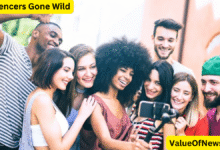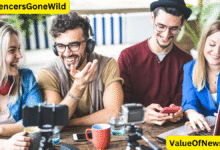InfluencersGoneWild In today’s digital world, the term “influencer” has evolved from a niche concept to a mainstream reality. These individuals, who have gained fame and amassed large followings across social media platforms, have transformed the way brands market themselves, how individuals relate to popular culture, and how trends are established. One of the more controversial and divisive movements in this space is a term gaining traction: “InfluencersGoneWild.” This phrase, often used in various online conversations, captures a particular type of influencer behavior that is characterized by pushing boundaries, embracing controversial content, or engaging in dramatic, attention-grabbing antics. But what does it mean for an influencer to “go wild,” and how has it shaped modern social media culture?
The Rise of Social Media Influencers
The digital age has brought about a massive shift in how people consume content. Social media platforms like Instagram, YouTube, TikTok, and Twitter have become arenas where anyone with the right combination of charisma, creativity, and strategic content can cultivate a devoted following. Influencers, who are individuals with the ability to InfluencersGoneWild the purchasing decisions, opinions, and behaviors of others, emerged from this shift. Over time, these personalities began to garner significant power, collaborating with brands, promoting products, and even shaping societal conversations.
At first, the role of an influencer was seen as aspirational. They were perceived as lifestyle experts, showcasing everything from beauty routines to travel diaries and fitness regimens. Their carefully curated images, seemingly flawless lives, and relatable content resonated with millions of followers. This initial wave of influencers set the tone for what was considered socially acceptable behavior on social media—polished, well-thought-out, and brand-friendly.
However, as the influencer landscape grew, so did the competition. With so many individuals trying to capture the spotlight, it became harder for influencers to maintain their relevance and keep their audiences engaged. This gave rise to the concept of “InfluencersGoneWild.”
What Does “InfluencersGoneWild” Really Mean?
The term “InfluencersGoneWild” refers to a subculture of influencers who take their online presence to the extreme. Instead of maintaining a pristine image, these influencers embrace controversy, pushing the limits of what is deemed acceptable or appropriate on social media. In many ways, “going wild” is about abandoning the traditional expectations of professionalism and decorum in favor of unfiltered, often rebellious, and sometimes provocative content.
While not all influencers who embrace this label engage in harmful or destructive behavior, they certainly gravitate toward showcasing the raw, unpolished, and sometimes outrageous aspects of their lives. This could include over-the-top pranks, bold fashion choices, explicit or sexual content, scandalous behavior, or public feuds with other influencers or celebrities. The idea is that by breaking free from societal norms, these influencers can grab the attention of the public, generate buzz, and ultimately grow their online presence.
The Appeal of Shocking Content
The appeal of shocking content in the influencer space cannot be understated. In a saturated market where nearly everyone is trying to capture the attention of the same audience, the need for differentiation becomes critical. “InfluencersGoneWild” thrive on this notion by turning up the volume on their content in a way that feels unpredictable, controversial, or audacious.
This type of content plays into human psychology. People are naturally drawn to what is different, what stands out, or what challenges the status quo. When an influencer posts something that seems outlandish or taboo, it not only attracts attention but also sparks conversation. The more buzz an influencer generates, the more likely they are to get noticed and, in turn, gain new followers or boost their personal brand. Whether it’s a provocative outfit choice, an unexpected collaboration, or a shocking opinion on a hot topic, these influencers leverage controversy to remain relevant and, in some cases, become viral sensations.
However, there’s a dark side to this attention-grabbing behavior. The pressure to continually “go wild” or produce shocking content can lead to burnout or a loss of authenticity. Some influencers may find themselves in a cycle of ever-escalating antics that ultimately overshadow their original brand, message, or purpose.
The Fine Line Between Authenticity and Shock Value
One of the main reasons why “InfluencersGoneWild” gain so much attention is because they blur the line between authenticity and shock value. In the world of social media, there is an ongoing debate about whether influencers should be “real” with their audiences, or if they should simply entertain and sell a fantasy.
For some influencers, “going wild” is their way of being raw and unfiltered, embracing imperfections and offering an unpolished look at their lives. This can be seen as a form of rebellion against the curated, perfect images that are often associated with traditional influencer culture. By showing their flaws, making mistakes, and pushing boundaries, they create a space where their audience feels a more genuine connection with them.
On the other hand, there are influencers who use shock value as a calculated tactic to increase engagement. They know that scandalous or controversial content will capture the attention of both fans and critics alike. The more dramatic and polarizing their actions, the more discussions they spark, and the greater their visibility becomes. In this case, the “wildness” is often less about authenticity and more about crafting a persona that keeps their followers hooked.
The Impact on Brands and Marketing
The rise of “InfluencersGoneWild” has also had a profound impact on marketing strategies and brand partnerships. Brands, especially those in lifestyle, fashion, or beauty, often collaborate with influencers to promote their products to a wider audience. However, partnering with influencers who engage in controversial or shocking behavior requires a delicate balancing act.
Brands must decide whether to align themselves with influencers who push boundaries, or stick with the more traditional, “safe” influencers who maintain a polished, professional image. For some companies, influencers with a reputation for going wild may be seen as a risky but necessary investment to tap into younger, more rebellious demographics. For others, the potential for negative backlash or reputation damage may outweigh the benefits.
There is also the consideration that influencers who go too far may alienate their followers or cause brand relationships to deteriorate. One wrong move, such as an inappropriate comment or an offensive prank, could lead to a loss of sponsorships, public outrage, or a damaged career.
The key takeaway for brands is that the line between wild and irresponsible is thin. While some brands are willing to take risks, others may prefer the safety of influencers who maintain a more controlled image.
The Dark Side: Exploiting the Audience
While some influencers thrive on the idea of pushing limits, others may be taking advantage of their followers. Many influencers, especially those who adopt the “gone wild” approach, use their platform to exploit emotional triggers, societal vulnerabilities, or personal insecurities. This is often done in the pursuit of views, likes, or brand deals. For example, influencers may share highly emotional or personal stories to generate sympathy or views, even if these stories aren’t entirely genuine.
This exploitation of audience emotions can have negative effects on followers, especially younger individuals who may be more impressionable. Constant exposure to drama-filled or controversial content can contribute to feelings of anxiety, insecurity, and an unhealthy desire for attention.
Furthermore, the perpetuation of unrealistic beauty standards, toxic relationships, and controversial behavior can create a distorted view of reality for their followers. The rise of “InfluencersGoneWild” has led to a larger conversation about social media’s impact on mental health, particularly among teens and young adults.
The Future of InfluencersGoneWild
As social media continues to evolve, the future of influencers and the “gone wild” phenomenon remains uncertain. While it’s clear that shocking and controversial content can still go viral, there is growing scrutiny about the sustainability of such behavior. More platforms are introducing stricter guidelines for acceptable content, and social media users are becoming increasingly aware of the potential negative effects of influencer-driven culture.
Influencers who want to maintain their relevance may need to find a balance between being authentic and embracing controversy. As audiences become more savvy and critical, influencers who resort too heavily to wild antics may risk losing their followers’ trust or their ability to connect with their audience on a meaningful level.
Furthermore, the role of influencers in shaping public opinion and brand perceptions may undergo significant changes. The growing push for mental health awareness and responsible online behavior could lead to a new wave of who InfluencersGoneWild focus on positivity, authenticity, and transparency, distancing themselves from the shock-value tactics that have defined the “gone wild” movement.
Conclusion
“InfluencersGoneWild” represents a specific subset of the influencer world where drama, controversy, and shocking content are used to stay relevant in an increasingly crowded digital space. While these influencers have found a way to capture attention, their path is fraught with challenges. As the digital landscape matures, the appeal of pushing boundaries may wane, giving way to a more thoughtful and responsible approach to influencer culture. Whether the “wild” side of influencers will continue to thrive or fade into the background will ultimately depend on how the social media ecosystem evolves, and how influencers adapt to meet the ever-changing expectations of their audiences.




